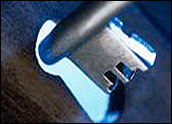
In the not-so-distant future, the mundane will become borderline miraculous. The home washing machine will order its own repairs and the sprinkler system will call you on your cell phone to say the lawn service has broken one of its water spouts and it is now wasting water.
The car will tell you to pull over — its left rear tire is low on air — and, by the way, the service department at the local dealership has an opening on Thursday, if that’s convenient for you. There seems to be a problem since your garage sensors have reported oil drippings on its floor.
Next, your home security system will ring you up and ask if it should let the repairman in to perform the service your washing machine ordered. The repairman’s work order number matches the one the washing machine assigned, so the service call is legit, reports the security system. “Press one to allow entry with video surveillance, two to reschedule the repairman or three to summon the police,” it might say.
It will all resemble something out of an episode of “The Jetsons,” yet there is something luxurious and comforting about being free from the monotony of daily details.
No Thinking Required
“Customers like the ability to get something without thinking about it, especially when it is a commodity they know they need and must have or use,” says Esteban Kolsky, research director, customer service and support CRM practice for Gartner.
From the CRM perspective, the opportunities home automation present seems limitless.
“It will actually strengthen the relationship with the customer. The machine will talk to the other machine to schedule service or to request parts, or something to that effect. But the end-result of that interaction is a more satisfied customer that gets what they need [proactively] rather than after the breakdown,” he added.
It could also be one heck of an annoyance.
“It depends on how companies handle it. If done well, customers will be happy with the service. If a company sees it solely as a means to increase revenue, customers will become resentful and there could be a backlash,” says Charles Golvin, principal analyst for Forrester Research.
The Proactive Approach
Golvin says CRM will have to maintain a customer-friendly, proactive approach to the technology and not just let the service dangle unattended.
Kolsky agrees. “It has to be done in a way that is nonintrusive, proper, fast and efficient. If any of the above is lacking, then the user will be annoyed at having to put up with it. We have seen some solutions that require end-user intervention, as an example, that have caused user revolts,” he warns. The point may be moot for a while yet.
The Continental Automated Buildings Association (CABA), a nonprofit industry association that promotes advanced technologies for the automation of homes and buildings in North America, reports that its consumer survey reveals that only 22 percent of consumers are familiar with the idea of a “connected home” and a mere 28 percent say they are interested in it.
Of those consumers who say they will adopt the technologies, the average number of years consumers reported they were likely to adopt was 12.
Adoption Rates May Vary
However, not all industry experts agree on the adoption rate or time frame.
“Its very early to predict adoption rates. Gartner sees this as an up-and-coming thing that will pan out in the next two to three years. We expect adoption, driven by acceptable prices, to be around 10 to 15 percent in that time frame, and grow from there to around 40 to 50 percent in six to seven years,” Kolsky comments.
Still, consumers are not exactly breaking down the doors to buy the stuff.
According to CABA, 73 percent say they will adopt at some point while 27 percent say they will never connect their homes. All in all, it sizes up to a very new and very large market.
“We believe home automation will be a significant market in the coming years, though at present it is in a very early stage of development, much earlier than home networking or broadband Internet,” says Sam Lucero, analyst for ABI Research.
Several Development Paths
Lucero says ABI Research is seeing development of home automation along three main axes:
- home monitoring, either through a service provider or in conjunction with a whole-home automation system;
- whole-home automation, essentially an analog of what an AMX or Creston Electronics would provide on the very high-end, but utilizing more recent technologies and standards, such as Zigbee, Z-Wave and Insteon, and targeting a mainstream customer base;
- and subsystems, such as lighting or irrigation control systems.
If the industry is developing home automation along these axes, but consumers are hesitant with adoption, what’s driving the market?
‘Slow But Steady’
Certainly the industry sees future profits to be had, but there is also a slow but steady consumer tide washing the technology forward.
“From the consumer’s viewpoint, 27-hours-per-day days and the constantly increasing speed of life is a driver in this market. Another is the discovery that if you automate certain transactions, you have that time for yourself to do something else you want or need,” says Kolsky.
Beyond the professional analysis and the marketing spin, is the sheer power of human nature.
“Sheer laziness and freedom from boring things are two of the biggest drivers,” says Kolsky.





















































